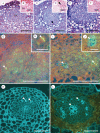Stamen development and winter dormancy in apricot (Prunus armeniaca)
- PMID: 21474504
- PMCID: PMC3170150
- DOI: 10.1093/aob/mcr056
Stamen development and winter dormancy in apricot (Prunus armeniaca)
Abstract
Background and aims: In temperate woody perennials, flower bud development is halted during the winter, when the buds enter dormancy. This dormant period is a prerequisite for adequate flowering, is genetically regulated, and plays a clear role in possibly adapting species and cultivars to climatic areas. However, information on the biological events underpinning dormancy is lacking. Stamen development, with clear differentiated stages, appears as a good framework to put dormancy in a developmental context. Here, stamen developmental changes are characterized in apricot (Prunus armeniaca) and are related to dormancy.
Methods: Stamen development was characterized cytochemically from the end of August to March, over 4 years. Developmental changes were related to dormancy, using the existing empirical information on chilling requirements.
Key results: Stamen development continued during the autumn, and the flower buds entered dormancy with a fully developed sporogenous tissue. Although no anatomical changes were observed during dormancy, breaking of dormancy occurred following a clear sequence of events. Starch accumulated in particular places, pre-empting further development in those areas. Vascular bundles developed and pollen mother cells underwent meiosis followed by microspore development.
Conclusions: Dormancy appears to mark a boundary between the development of the sporogenous tissue and the occurrence of meiosis for further microspore development. Breaking of dormancy occurs following a clear sequence of events, providing a developmental context in which to study winter dormancy and to evaluate differences in chilling requirements among genotypes.
Figures





Similar articles
-
Anther and pollen development in sweet cherry (Prunus avium L.) in relation to winter dormancy.Protoplasma. 2019 May;256(3):733-744. doi: 10.1007/s00709-018-01332-4. Epub 2018 Nov 30. Protoplasma. 2019. PMID: 30506265
-
Meta-analysis of RNA-Seq studies reveals genes with dominant functions during flower bud endo- to eco-dormancy transition in Prunus species.Sci Rep. 2021 Jun 23;11(1):13173. doi: 10.1038/s41598-021-92600-6. Sci Rep. 2021. PMID: 34162991 Free PMC article.
-
miR169 and PmRGL2 synergistically regulate the NF-Y complex to activate dormancy release in Japanese apricot (Prunus mume Sieb. et Zucc.).Plant Mol Biol. 2021 Jan;105(1-2):83-97. doi: 10.1007/s11103-020-01070-3. Epub 2020 Sep 14. Plant Mol Biol. 2021. PMID: 32926248
-
Beyond floral initiation: the role of flower bud dormancy in flowering time control of annual plants.J Exp Bot. 2024 Oct 16;75(19):6056-6062. doi: 10.1093/jxb/erae223. J Exp Bot. 2024. PMID: 38795335 Free PMC article. Review.
-
Regulatory Mechanisms of Bud Dormancy: Environmental, Hormonal, and Genetic Perspectives.Int J Mol Sci. 2025 Mar 11;26(6):2517. doi: 10.3390/ijms26062517. Int J Mol Sci. 2025. PMID: 40141161 Free PMC article. Review.
Cited by
-
Pollen development in Rhododendron in relation to winter dormancy and bloom time.Protoplasma. 2015 Sep;252(5):1313-23. doi: 10.1007/s00709-015-0764-y. Epub 2015 Feb 3. Protoplasma. 2015. PMID: 25643916
-
Pistil starch reserves at anthesis correlate with final flower fate in avocado (Persea americana).PLoS One. 2013 Oct 22;8(10):e78467. doi: 10.1371/journal.pone.0078467. eCollection 2013. PLoS One. 2013. PMID: 24167627 Free PMC article.
-
Identification, Structural and Functional Characterization of Dormancy Regulator Genes in Apricot (Prunus armeniaca L.).Front Plant Sci. 2019 Apr 5;10:402. doi: 10.3389/fpls.2019.00402. eCollection 2019. Front Plant Sci. 2019. PMID: 31024581 Free PMC article.
-
Sexual plant reproduction.Ann Bot. 2011 Sep;108(4):585-7. doi: 10.1093/aob/mcr217. Ann Bot. 2011. PMID: 22010286 Free PMC article. No abstract available.
-
Persian Walnut (Juglans regia L.) Bud Dormancy Dynamics in Northern Patagonia, Argentina.Front Plant Sci. 2022 Feb 3;12:803878. doi: 10.3389/fpls.2021.803878. eCollection 2021. Front Plant Sci. 2022. PMID: 35185955 Free PMC article.
References
-
- Arora R, Rowland LJ, Tanino K. Induction and release of bud dormancy in woody perennials: a science comes of age. Hortscience. 2003;38:911–921.
-
- Ashworth EN, Davis GA, Wisniewski ME. The formation and distribution of ice within dormant and deacclimated peach flower buds. Plant Cell and Environment. 1989;12:521–528.
-
- Bartolini S, Viti R, Guerriero R. Xylem differentiation and microsporogenesis during dormancy of apricot flower buds (Prunus armeniaca L.) European Journal of Horticultural Science. 2006;71:84–90.

